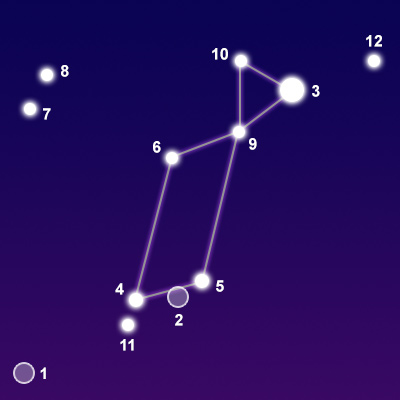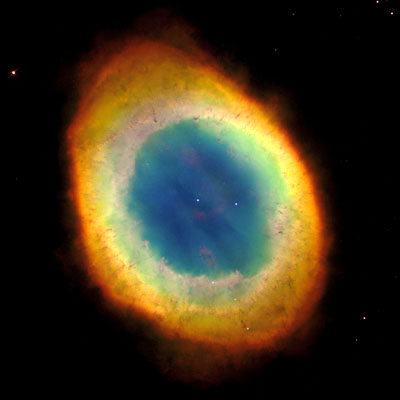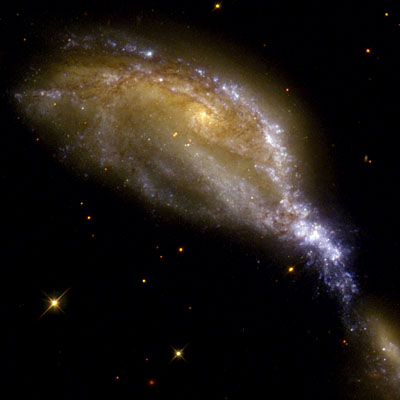Pronunciation:
(LY-ruh)Abbreviation:
LyrGenitive:
LyraeRight Ascension:
19 hoursDeclination:
40 degreesArea in Square Degrees:
286Crosses Meridian:
9 PM, August 15Visible Between Latitudes:
90 and -40 degreesThe constellation Lyra, the lyre, is best seen from June through October in the northern hemisphere. It is visible between latitudes 90 degrees and -40 degrees. It is a small constellation, covering an area of 286 degrees of the sky. It ranks 52nd in size among the 88 constellations in the night sky. It is bordered by Vulpecula to the south, Hercules to the east, Draco to the north, and Cygnus to the west. Vega, the brightest star in Lyra, forms a large triangle with two other stars, Altair in Aquila and Deneb in Cygnus. This prominent formation of bright stars is known as the Summer Triangle. Lyra is also the origin point for the annual Lyrids meteor shower which occurs every year in April.
Lyra is one of the 48 constellations listed by the Greek astronomer Ptolemy in the second century. It represents the lyre, a musical instrument with strings that resembles a harp. It is associated with the myth of the Greek musician Orpheus. The lyre was invented by Hermes as a gift to his half-brother Apollo, who gave it to Orpheus, the musician of the Argonauts. Orpheus was so gifted with his music that even inanimate objects such as trees, streams, and rocks could be charmed. After his death, his lyre was thrown into a river. Zeus sent an eagle to retrieve it and both Orpheus and the Lyre were placed in the heavens as constellations.

points of interest below © Sea and Sky

© Torsten Bronger CC BY-SA 3.0
M57
Vega
Sulafat
Sheliak
Delta-2 Lyrae
Theya Lyrae
Aladfar
Zeta Lyrae
Epsilon Lyrae
Lambda Lyrae
Alathfar
Ring Nebula
"Falling Eagle"
"The Turtle"
"Lyra"
N/A
N/A
"The Talons"
N/A
N/A
N/A
"The Talons"
Planetary Nebula
Blue Subgiant Star
Blue Giant Star
Binary Star System
Red Giant Star
Trinary Star System
Blue Subdwarf Star
Multiple Star System
Multiple Star System
Orange Giant Star
Blue-White Subdwarf Star
8.80
0.03
3.24
3.52
4.30
4.35
4.39
4.40
4.70
4.94
5.12
Lyra is a small, dim constellation, but it is home to the fifth brightest star in the sky, Vega. With a visual magnitude of 0.03, it is the brightest star in Vega and the second brightest star in the northern hemisphere. Vega is a blue subgiant star located only 25 light years from Earth. The second brightest star in Lyra is Sulafat with a magnitude of 3.24. It is a blue giant star that lies 620 light years away. With a magnitude of 3.52, Sheliak is the third brightest star. It is a binary star system located some 960 light years from our solar system.
Lyra contains two Messier Objects. The most famous of these is M57, the Ring Nebula. This colorful object is a planetary nebula formed when a star expelled its outer layer of gas. M56 is a tight globular cluster which contains thousands of stars. It is 84 light years across and is located over 32,000 light years from Earth. There are a few other deep-sky objects in this constellation, but they are extremely dim and can only be seen with a large telescope. The most notable of these is an irregular galaxy known as NGC 6745. It is believed to have been a spiral galaxy at one time but was deformed after a close encounter with another galaxy.

the Hubble Space Telescope

the Hubble Space Telescope

the Hubble Space Telescope



